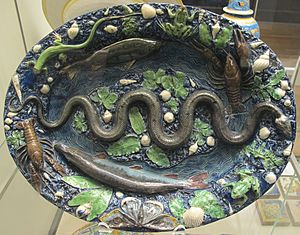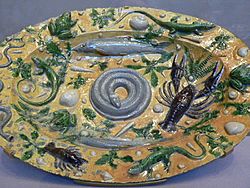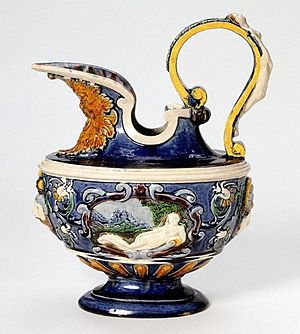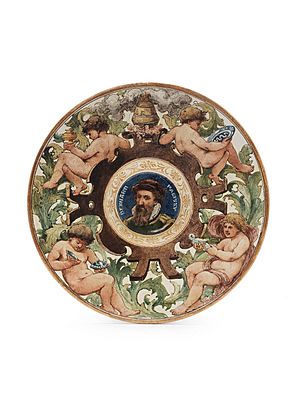Bernard Palissy facts for kids
Quick facts for kids
Bernard Palissy
|
|
|---|---|

Bernard Palissy, self-portrait in faience, reproduced in a lithograph
|
|
| Occupation | French Huguenot pottery and hydraulics engineer |
Bernard Palissy (born around 1510, died around 1589) was a famous French potter, water engineer, and craftsman. He was known for his amazing "rusticware" pottery. These were large, oval dishes decorated with small animals and plants that looked very real.
Palissy was also important for his discoveries in natural sciences. He learned a lot about geology (the study of Earth's rocks and soil), hydrology (the study of water), and how fossils are formed.
He was a Protestant during a time of religious conflict in France. Because of his beliefs, he was put in prison and died there in 1589.
Contents
Bernard Palissy's Early Life
Bernard Palissy was born around 1510. We don't know exactly where, but it was likely in a region of France called Saintonge. His family was not rich. Even though he didn't learn Greek or Latin, he was taught practical subjects like geometry and surveying.
Early in his life, Palissy worked for the king, mapping out salt marshes. He also learned to be a glass-painter. After his training, he traveled all over France and even to other countries like the Low Countries (modern-day Netherlands and Belgium) and Italy. This helped him learn many new things.
After his travels, Palissy returned to Saintonge. He got married and had children. For a while, he worked as a portrait painter, glass painter, and land surveyor to support his family.
How He Got Interested in Pottery
Around 1539 or 1540, Palissy saw a beautiful white cup with shiny enamel. He was so amazed by it that he decided he had to figure out how it was made. This cup might have come from Italy or even China.
At a nearby village, Palissy learned the basics of making simple pottery. He also studied how European white-enameled pottery was made. He experimented with many different materials, like tin, lead, copper, and sand, trying to create the perfect glaze.
Creating "Rustic Pottery"
For almost sixteen years, Palissy worked incredibly hard to recreate the pottery he had seen. He faced many difficulties and failures. Sometimes, his family was very poor. It's even said that he burned his furniture to keep his pottery kilns hot! His wife and children often struggled for food, and they probably thought his efforts were a bit crazy. Palissy wrote about all these struggles in his own story.
He never managed to make Chinese porcelain or white tin-glazed pottery. But through his experiments, he created his own unique style called "Palissy ware" or "rustic pottery." This pottery is famous for its colorful lead glazes. The dishes are decorated with realistic animals and plants, often from the marshes near his home in Saintonge. You can see fish, crabs, snakes, ferns, and flowers on his pieces.
Around 1542, a peasant uprising happened in Saintonge. A powerful French leader, the Duc de Montmorency, came to the area. He was very impressed by Palissy's art. The duke hired Palissy to create special gardens and ceramic creatures for his castles. This work was in a romantic style, similar to famous Italian artists of the time.
Working in Paris
In 1548, Palissy moved to Paris. He was protected by the powerful Montmorency and Queen Catherine de' Medici. Even though Palissy had become a Protestant in 1546 (which was different from the main Catholic religion), Catherine asked him to design gardens for her at the Tuileries palace. In 1562, she gave him an official title: "the king's inventor of rustic figurines."
Palissy was very open about his Protestant faith. He sometimes even criticized important officials using quotes from the Bible. Despite this, the nobles protected him. In 1562, his workshops were destroyed, but he was saved because of his royal connections. He was then appointed as the royal potter.
Around 1563, with the king's protection, he set up a new pottery workshop in Paris, near the royal palace of the Louvre. His kilns were even located where part of the Tuileries Garden is today. For about 25 years, Palissy lived and worked in Paris. He remained a favorite of Queen Catherine de' Medici and her sons, even with his Protestant beliefs. She might have even saved him during a terrible event called the Saint Bartholemew's Day Massacre in 1572.
During his time working for the court, he made many different kinds of pottery. Besides his famous rustic figurines, he also created dishes and plaques decorated with scenes from the Bible or old myths.
Lectures on Natural Science
While in Paris, Palissy gave public lectures on natural history. People paid a good amount of money to hear him speak. His ideas about springs, underground water, metals, and stones were published in a book in 1580. He was one of the first people in Europe to correctly explain how fossils are formed. His ideas about water systems for cities were also very advanced for his time.
Palissy believed that practical experience was more important than just theory. He thought that you couldn't truly understand something without trying it out yourself.
He described ways to get and move water, and how to make sure it was clean. He even offered to help anyone who couldn't follow his instructions! He also had theories about volcanoes and earthquakes, believing they were caused by things burning under the Earth's surface. Palissy correctly figured out how natural springs work when he studied water and geology.
Palissy also correctly argued that fossils were the remains of living things that had died long ago. He disagreed with the common belief that they were formed by a great flood or by stars. He thought that minerals in water would turn dead organisms into stone, creating fossils.
Imprisonment and Death
Palissy's life ended much like his active and challenging youth. Even with the protection of powerful nobles, a strong religious conflict in 1588 led to him being thrown into the Bastille prison. It is said that King Henry III offered Palissy his freedom if he would change his religious beliefs, but Palissy refused.
He was nearly 80 years old when he was condemned to a very serious punishment. He died in the Bastille prison in 1590 due to the harsh conditions.
Bernard Palissy in Stories
Bernard Palissy's work has appeared in many stories and books:
- In Alexandre Dumas's famous book The Count of Monte Cristo, Palissy's platters are mentioned as part of a very fancy apartment.
- Marcel Proust mentions Palissy in his book Remembrance of Things Past, describing a fish dish that looked like a Palissy ceramic.
- His life and work are also described in A.S. Byatt's book The Children's Book, where he inspires other potters.
Images for kids
See also
 In Spanish: Bernard Palissy para niños
In Spanish: Bernard Palissy para niños
- Lead-glazed earthenware
- Majolica








